中英对照初中英语教案模板
初中英语教案设计模板全英文版(共8篇)
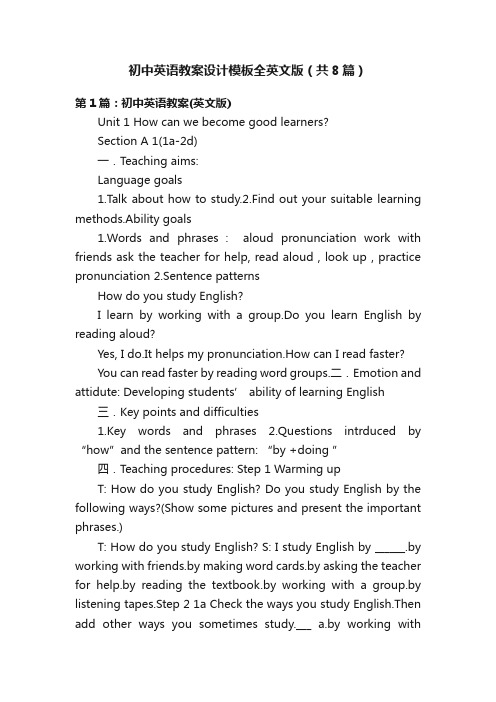
初中英语教案设计模板全英文版(共8篇)第1篇:初中英语教案(英文版)Unit 1 How can we become good learners?Section A 1(1a-2d)一.Teaching aims:Language goals1.Talk about how to study.2.Find out your suitable learning methods.Ability goals1.Words and phrases:aloud pronunciation work with friends ask the teacher for help, read aloud , look up , practice pronunciation2.Sentence patternsHow do you study English?I learn by working with a group.Do you learn English by reading aloud?Yes, I do.It helps my pronunciation.How can I read faster?You can read faster by reading word groups.二.Emotion and attidute: Developing students’ ability of learning English 三.Key points and difficulties1.Key words and phrases2.Questions intrduced by “how”and the sentence pattern: “by +doing ”四.Teaching procedures: Step 1 Warming upT: How do you study English? Do you study English by the following ways?(Show some pictures and present the important phrases.)T: How do you study English? S: I study English by ______.by working with friends.by making word cards.by asking the teacher for help.by reading the textbook.by working with a group.by listening tapes.Step 2 1a Check the ways you study English.Then add other ways you sometimes study.___ a.by working withfriends.___ b.by making word card.___ c.by reading the textbook.___ d.by listening to tapes ___ e.by asking the teacher for help.…Step 3 Listening1)Listen.How do these students study for a test? Write letters from 1a above.2)Check the answers: b(Meiping);e(Peter);d(Tony)Step 4 Gue Show some pictures.Gue: How does he/she study English? He/She studies English by…How do they study English? They study English by… Step 5 Pairwork1c Make conversations about how you study for a test.A: How do you study for a test?B: I study by working with a group.A: How do you study for a test?B: I study by… Step 6 Listening2a Listen and check the questions you hear.1 ____ Does anyone learn English by watching videos? 2 ____ Do you have conversations with friends in English? 3 ____ What about listening to tapes? 4 ____ What about reading aloud to practice pronunciation? 5 ____ Have you ever studied with a group?Answers: 1, 2, 4, 5 2b Listen again.Match each answer below with a question above.a.Yes, I have.I’ve learned a lot that way.b.Oh, yes.It really improves my speaking skills.c.I do that sometimes.I think it helps.d.No.It’s too hard to understand spoken English.Answers: d, b, c, a Step 7 Pairwork 1.2c Make conversations using the information in 2a and 2bA: Have you ever studied with a group?B: Yes, I have.I’ve learned a lot that way.Show some pictures.1)A: Do you learn English by watching movies?B: Yes, it’s a very interesting way.C: No, it’s too hard tounderstand spoken English.2)A: What about writing letters to a pen pal in America?B: Yes, it helps to improve my writing skills and know a lot aboutAmerica.3)A: Do you have conversations with friends in English?B: Of course, we can talk about plenty of things like school, pets,movies, and our parents.Step 8 SummaryHow do you study English?1.by working with friends2.by watching English movies.3.by making word cards.4.by reading the textbook.5.by listening to tapes.6.by asking the teacher for help.7.by reading aloud.Step9 Homework How do you study English? What about physics and Chinese? Make a list.第2篇:初中英语说课稿获奖全英文版Oral Presentation of Leon Plan for Unit 12 My favorite subject is science Go for it Grade 7(注:本说课稿根据“2007年首届全国中学英语教师教学基本功大赛暨教学观摩研讨会(初中)”)[Presenting the 1st PPT about the introduction.] Well, good afternoon ladies and gentlemen, I am very happy to meet you all here.Today,I am going to present Unit 12 Writing.Well, please look at the teaching material together.Well, this is a letter in the book.Students are required to read it through, have a look at it, try to write a letter to Zhao Jie, a boy who doesn’t like any subjects at all.[Presenting the 2nd PPT about the given letter.] Well, I think my teaching aims should include the proper form of English letter, and second, how to write a letter in an idiomatic way.[Presenting the 3rd PPT about the teaching aims.]Well, to achieve these goals, I am going to arrange myteaching step by step [Presenting the 4th PPT about the teaching procedures].Well, these are the steps, since so many, let me make it simple, actually, they are words, sentences and paragraphs.As we know that articles consist of words and sentences.So first, I would like to talk about the words.That is also the first step---revision.Well, you know, students have learned the names of the subjects in the former leons.So, I am going to review the words by playing games with them.Here comes the first game: who can write more? [Presenting the 5th PPT about the 1st game]I am going to divide the students into two groups, for example boys and girls.They are given two minutes to rush to the blackboard and write down the subjects they know.The group which can write more will be the winner.Imagine how excited the students are, and at the same time, they are also reviewing the words.Well, what’s more, you may have noticed these two subjects, Physics and Chemistry.[Presenting the 6th PPT about the result of the game] Actually, these two subjects are not in this book.So, in this way, we can know that some students are showing us how much they know and all the students can also enlarge their vocabulary at the same time.Well, after words, I would like to turn to sentences.Here comes the second game, who can make it longer? [Presenting the 7th PPT about the 2nd game] I am going to give students a word, for example subject.Which students can make it longer? Well, you please.Favorite subject.Good.A phrase appears.Longer? You please.My favorite subject is English.Well, a sentence appears.Even longer? My favorite subject is English, I like it very much, it is so interesting.[Presenting the 8th PPT about the answers of the game]Well, you can see students are constructing words into sentences step by step.Well, this is the revision part.After that, it is time to read.From now, I am going toshow students the given material so soon.Actually, instead, I am going to show them those separated pieces.They should put them into the correct order[Presenting the 9th PPT about the reordering task].You know before the leon, I divided the whole letter into these four parts, why do I bother to do this? Well, you can see, in this way, students can put more attention to how to begin and how to end a letter.Then, they have a time, can have a chance to read through the whole article[Presenting the 10 th PPT about the reading material].Well, at the same time, they should also pick out those well used words and sentences, and share them with the whole cla.Then, they have a discuion “what information can we use? [Presenting the 11th PPT about the discuion task]Why talking about subjects? Of course, it is easy for them to find these information like these three ones(time & day, teacher, reason), because they are in the letter.But what else? Students need to think about that.Well, why? As we know it is easy to copy, but difficult to create.Sometimes, the given material gives us a good example, but sometimes, they may also limit students’ ideas.So they need to go further.As some teachers may prefer to offer the answers directly to the students.But I am not.I think teaching students how to learn is much more important than just teaching knowledge.So students should think about that by themselves.Well, this part is also a brainstorm to them.Till now, they have known so much.Since that, they should be given a chance to put wha t they’ve known into practice.So I prepare two practices[Presenting the 12th PPT about the 2 practices].Practice number one, students have a Free Talk about their favorite subjects, if they can expre themselves fluently and naturally, they won’t have much difficulty in writing them down.Well, second practice will be the real writing.They aregiven eight minutes to write a letter to Zhao Jie[Presenting the 13th PPT about the beginning of the letter].Well, when they finish writing, six students get into a group, they exchange their letters and try to correct mistakes.Why they should do that? Well, teachers may have noticed that not many students have the habit of rewriting and correcting mistakes when they finish writing, and I want them to realize this is also very important.Ok, after that, each group chooses two representatives, the best one and the one who has made great progre.Which two? I think not only those advanced students but also the le advanced students should be given a chance to show how good they are.Well, for example, yes, after that, some representative come to the front and show their letters to the whole cla, but you can think it is a projector like this.This is a student’s letter and when all students finish writing it, they are welcomed to give comments.It is so-so, good or great.So which one? Can you find any beautifull sentences here? They are welcomed to give their ideas.Well, here comes the last part[Presenting the 14th PPT about the homework].Last part will be the homework.They can either write me an email or have a talk with some one or write an article about his or her favorite ********.I think both of these are highly connected with our daily life.So, students must be very interested.Ok, so that is all.Thank you very much!(答辩问答)Questions:Anyhow, I appreciate your teaching, and allow me to say so.My question is “ how do you check the achievements of the homework you send to your pupils?Answer:Well, about this question, I think, first, still the group work.They should exchange their letters and each group should also choose two representatives and hand in the letters or the articles they have written to me, and I correct them bymyself.And then, put all these representatives’ works on the wall and show them to the whole cla.By this way.Thank you!第3篇:全英初中英语教案鲁人办发[2008]78号关于做好2008年省内高校特困家庭毕业生求职补贴发放工作的通知各高等学校:按照山东省人民政府办公厅《关于做好特困家庭高校毕业生就业工作的通知》(鲁政办发[2008]21号)要求,现就做好2008年省内高校特困家庭毕业生求职补贴发放工作有关事项通知如下:一、发放范围求职补贴发放范围为符合城乡低保、零就业家庭、农村贫困家庭等特殊情况,就业有困难需要帮助的2008年省内高校山东生源应届毕业生(以下简称特困生)。
初中英语教案全英模板

Subject: EnglishGrade Level: Junior High SchoolSubject Teacher: [Teacher's Name]Date: [Date]Class Duration: [Duration in minutes]---I. Introduction (5 minutes)1. Objective: To engage students in the lesson and set the context.2. Activities:- Greet students and ask them how they are feeling today.- Briefly review the previous lesson’s main points.- Introduce the topic of today’s lesson with a relevant question or prompt.II. Warm-Up (10 minutes)1. Objective: To activate prior knowledge and prepare students for the new content.2. Activities:- Conduct a quick vocabulary review using flashcards or a related game.- Have students participate in a short group discussion on a topic related to the lesson.III. Presentation (15 minutes)1. Objective: To introduce new vocabulary, grammar, and concepts.2. Activities:- Use visual aids, such as pictures, videos, or realia, to present new vocabulary.- Demonstrate grammar structures through examples and explanations.- Use interactive whiteboard or projectors to display information clearly.IV. Practice (20 minutes)1. Objective: To provide students with opportunities to practice the new language.2. Activities:- Pair work or group activities to practice vocabulary and grammar.- Role-playing exercises to simulate real-life situations.- Use of worksheets or handouts for structured practice.V. Application (15 minutes)1. Objective: To apply the new language in a meaningful context.2. Activities:- Have students create short dialogues or narratives using the new vocabulary and grammar.- Assign a small project or task that requires the application of the new skills.VI. Review and Feedback (10 minutes)1. Objective: To reinforce learning and provide students with feedback.2. Activities:- Go over the main points of the lesson with a quick quiz orquestion-and-answer session.- Collect and review student work to provide constructive feedback.VII. Homework Assignment (5 minutes)1. Objective: To extend learning beyond the classroom.2. Activities:- Assign relevant homework that reinforces the lesson’s content.- Provide specific instructions and due dates.VIII. Closing (5 minutes)1. Objective: To wrap up the lesson and prepare students for the next class.2. Activities:- Summarize the main points of the lesson.- Ask students to share their thoughts or questions about the lesson.- Assign a class task or preparation for the next lesson.---Additional Notes:- Assessment: Include specific criteria for evaluating student performance in each activity.- Differentiation: Adapt activities to meet the needs of diverse learners.- Materials Needed: List all materials required for the lesson,including textbooks, handouts, technology, etc.- Resources: Provide references to additional resources that can be used to support the lesson.---This template is designed to be flexible and adaptable to various teaching styles and lesson objectives. Adjust the activities andduration as needed to fit the specific needs of your students and the curriculum.。
初中英语笔试教案模板全英文
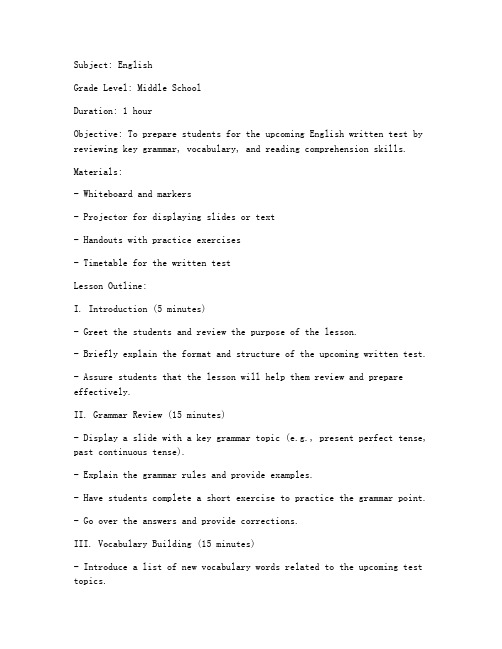
Subject: EnglishGrade Level: Middle SchoolDuration: 1 hourObjective: To prepare students for the upcoming English written test by reviewing key grammar, vocabulary, and reading comprehension skills.Materials:- Whiteboard and markers- Projector for displaying slides or text- Handouts with practice exercises- Timetable for the written testLesson Outline:I. Introduction (5 minutes)- Greet the students and review the purpose of the lesson.- Briefly explain the format and structure of the upcoming written test.- Assure students that the lesson will help them review and prepare effectively.II. Grammar Review (15 minutes)- Display a slide with a key grammar topic (e.g., present perfect tense, past continuous tense).- Explain the grammar rules and provide examples.- Have students complete a short exercise to practice the grammar point.- Go over the answers and provide corrections.III. Vocabulary Building (15 minutes)- Introduce a list of new vocabulary words related to the upcoming test topics.- Use visuals or real-life examples to help students understand the meanings.- Have students use the new words in sentences or complete a vocabulary matching exercise.- Review the words and their meanings.IV. Reading Comprehension Practice (15 minutes)- Provide a short passage or reading excerpt related to the test topics.- Have students read the passage silently and then answer comprehension questions.- Discuss the passage as a class, focusing on main ideas, details, and inference.- Review the answers and discuss any misconceptions.V. Writing Skills (10 minutes)- Briefly discuss a writing task that might appear in the test (e.g., a short essay or a letter).- Provide a sample outline or structure for the writing task.- Have students brainstorm ideas and outline their own response.- Review the outlines and provide feedback on structure and content.VI. Practice Exercises (10 minutes)- Distribute handouts with a variety of practice exercises covering grammar, vocabulary, and reading comprehension.- Instruct students to work independently or in pairs to complete the exercises.- Monitor students and provide assistance as needed.VII. Review and Closure (5 minutes)- Go over any remaining questions or doubts students may have.- Summarize the key points covered in the lesson.- Encourage students to review the material further and ask for help if needed.- Thank students for their participation and dismiss them.Assessment:- Evaluate students' participation and engagement throughout the lesson.- Assess the quality of their practice exercises and writing outlines.- Provide feedback on strengths and areas for improvement.Additional Notes:- Ensure that the lesson is interactive and encourages student participation.- Adapt the lesson plan to cater to the specific needs and abilities of your students.- Use a variety of teaching methods, including visual aids, interactive activities, and group discussions.- Keep the pace of the lesson manageable and ensure that all students have the opportunity to learn and practice.---This template can be adapted for different levels and topics within the middle school English curriculum. Remember to tailor the content and activities to suit the specific needs and abilities of your students.。
中英对照初中英语教案模板
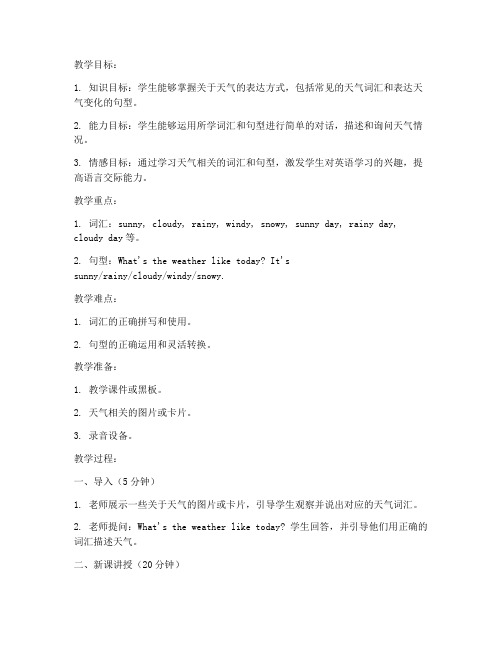
教学目标:1. 知识目标:学生能够掌握关于天气的表达方式,包括常见的天气词汇和表达天气变化的句型。
2. 能力目标:学生能够运用所学词汇和句型进行简单的对话,描述和询问天气情况。
3. 情感目标:通过学习天气相关的词汇和句型,激发学生对英语学习的兴趣,提高语言交际能力。
教学重点:1. 词汇:sunny, cloudy, rainy, windy, snowy, sunny day, rainy day, cloudy day等。
2. 句型:What's the weather like today? It'ssunny/rainy/cloudy/windy/snowy.教学难点:1. 词汇的正确拼写和使用。
2. 句型的正确运用和灵活转换。
教学准备:1. 教学课件或黑板。
2. 天气相关的图片或卡片。
3. 录音设备。
教学过程:一、导入(5分钟)1. 老师展示一些关于天气的图片或卡片,引导学生观察并说出对应的天气词汇。
2. 老师提问:What's the weather like today? 学生回答,并引导他们用正确的词汇描述天气。
二、新课讲授(20分钟)1. 老师通过课件或黑板,介绍天气相关的基本词汇,如sunny, cloudy, rainy, windy, snowy等。
2. 老师讲解并示范句型:What's the weather like today? It'ssunny/rainy/cloudy/windy/snowy.3. 学生跟读并模仿,老师纠正发音和语调。
三、巩固练习(15分钟)1. 老师组织学生进行小组活动,让学生用所学词汇和句型描述不同天气情况下的活动。
2. 学生互相提问,如:What's the weather like today? What will you do? 等。
3. 老师巡回指导,纠正学生的发音和语法错误。
四、课堂小结(5分钟)1. 老师带领学生回顾本节课所学内容,强调重点词汇和句型。
2024年牛津译林版初中英语教案模板全英文
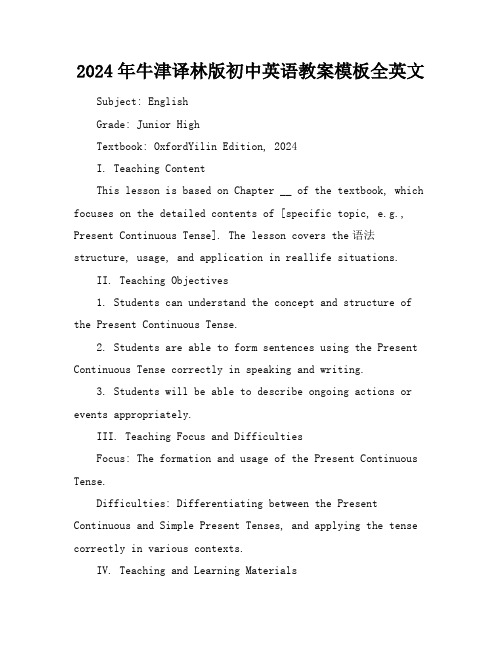
2024年牛津译林版初中英语教案模板全英文Subject: EnglishGrade: Junior HighTextbook: OxfordYilin Edition, 2024I. Teaching ContentThis lesson is based on Chapter __ of the textbook, which focuses on the detailed contents of [specific topic, e.g., Present Continuous Tense]. The lesson covers the语法structure, usage, and application in reallife situations.II. Teaching Objectives1. Students can understand the concept and structure of the Present Continuous Tense.2. Students are able to form sentences using the Present Continuous Tense correctly in speaking and writing.3. Students will be able to describe ongoing actions or events appropriately.III. Teaching Focus and DifficultiesFocus: The formation and usage of the Present Continuous Tense.Difficulties: Differentiating between the Present Continuous and Simple Present Tenses, and applying the tense correctly in various contexts.IV. Teaching and Learning Materials1. Textbook2. Whiteboard/Blackboard3. Visual aids (pictures, charts)4. Handouts with practice exercisesV. Teaching Process1. Introduction (5 minutes)Engage students with a practical scenario, e.g., showing pictures of people engaged in different ongoing activities.Elicit from students what they observe and encourage them to describe the actions using present tense.2. Presentation (15 minutes)Present the grammar rule of the Present Continuous Tense, emphasizing the usage of "am/is/are + verbing."Provide examples on the board, explaining the structure and function of the tense.Conduct choral repetition and individual practice to ensure understanding.3. Guided Practice (15 minutes)Give out handouts with guided exercises for students to practice forming sentences in Present Continuous Tense.Walk around the classroom to provide assistance and feedback.4. Interactive Activity (10 minutes)Organize an "Interview" activity where students ask and answer questions about ongoing actions using the Present Continuous Tense.5. Explanation and Clarification (10 minutes)Provide additional examples and practice to reinforce learning.6. Independent Practice (15 minutes)Assign a worksheet with various exercises, including fillintheblanks, sentence transformations, and writing prompts.Allow students to work individually while providing help to those in need.7. Review and Consolidation (10 minutes)Recap the main points of the lesson with students' participation.Review answers to the independent practice worksheet as a whole class.VI. Blackboard DesignThe board will be divided into sections:1. Title: Present Continuous Tense2. Grammar rules and examples3. Space for studentgenerated sentences4. Common errors and correctionsVII. Homework Design1. Write a short paragraph describing what your family members are doing right now.Example Answer: My brother is playing video games, my mother is cooking dinner, and my father is reading the newspaper.2. Create a dialogue between two friends meeting unexpectedly, using at least 10 sentences with the Present Continuous Tense.Answer Key will be provided with correct usage of the tense in the dialogue.VIII. Reflection and ExtensionReflect on the effectiveness of the practical scenario and interactive activities in engaging students.Consider modifications for future lessons to address any persisting difficulties.Provide extension activities for students seeking additional challenges, such as writing a story using the Present Continuous Tense or conducting an interview with a family member about their current activities.重点和难点解析:1. 教学难点与重点的明确;2. 教学过程中的实践情景引入;3. 教学过程中的互动活动设计;4. 板书设计;5. 作业设计;6. 课后反思及拓展延伸。
初中英语教案全英文班模板
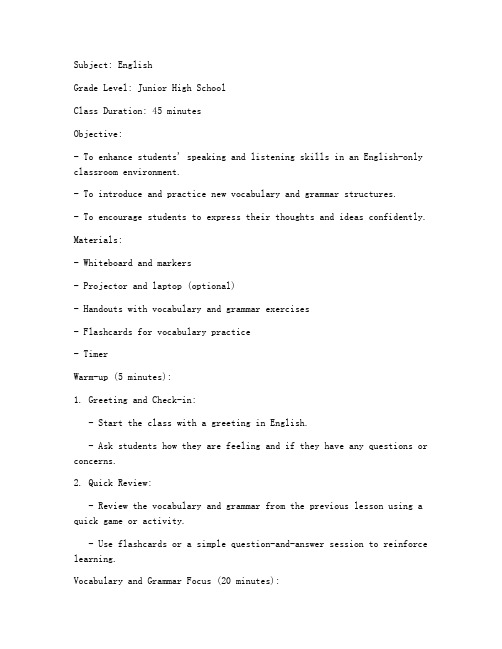
Subject: EnglishGrade Level: Junior High SchoolClass Duration: 45 minutesObjective:- To enhance students' speaking and listening skills in an English-only classroom environment.- To introduce and practice new vocabulary and grammar structures.- To encourage students to express their thoughts and ideas confidently.Materials:- Whiteboard and markers- Projector and laptop (optional)- Handouts with vocabulary and grammar exercises- Flashcards for vocabulary practice- TimerWarm-up (5 minutes):1. Greeting and Check-in:- Start the class with a greeting in English.- Ask students how they are feeling and if they have any questions or concerns.2. Quick Review:- Review the vocabulary and grammar from the previous lesson using a quick game or activity.- Use flashcards or a simple question-and-answer session to reinforce learning.Vocabulary and Grammar Focus (20 minutes):1. Introduce New Vocabulary:- Present new vocabulary items related to the theme of the lesson.- Use images, gestures, or examples to help students understand the meaning of the new words.2. Grammar Explanation:- Explain the grammar structure that will be used in the lesson.- Use simple and clear explanations, and provide examples to illustrate the usage.3. Interactive Practice:- Engage students in interactive activities to practice the new vocabulary and grammar.- Use pair work, group activities, or whole-class discussions to encourage participation.4. Worksheet Activity:- Distribute handouts with exercises related to the new vocabulary and grammar.- Allow students to work on the exercises individually or in pairs, providing guidance as needed.Speaking and Listening Activity (15 minutes):1. Role-Play Scenarios:- Create real-life scenarios that require students to use the new vocabulary and grammar.- Assign roles to students and have them act out the scenarios, encouraging them to speak in full sentences.2. Listening Comprehension:- Play a short audio clip or video related to the lesson topic.- Ask students questions about the content to check their understanding and listening skills.Wrap-up and Assessment (5 minutes):1. Summary:- Review the main points of the lesson, including new vocabulary and grammar.- Use a visual aid, such as a mind map or a chart, to help students remember the key concepts.2. Assessment:- Conduct a quick formative assessment to gauge students' understanding of the lesson.- This could be a short quiz, a class discussion, or a reflection on what they have learned.Homework:- Assign homework that reinforces the lesson's vocabulary and grammar.- Provide resources or suggestions for students to practice at home, such as reading materials or online exercises.Reflection:- After the class, reflect on what went well and what could be improved.- Consider student feedback and adjust the lesson plan for future classes to ensure continuous improvement in the English language learning environment.。
最新初中英语教案英文版(优秀四篇)

最新初中英语教案英文版(优秀四篇)初中英语教案英文版篇一how many desks are there? there are thirty-two. a book ten bookshow many接可数名词复数形式的.句型;数字1-10的拼写多媒体、录音机课时 1s1: how many …are there-s2: there are…ng.g-up1)learn the numbers 1-10. then listen and match.2) students listen and say the numbers.3) listen and say:t: what’re these/those?s: they’re eyes..t: how many desks are there?s: there are 32.work in pairs. ask and say.s1: what’re these?1) write the numbers.2) look at the pictures and write the phrases.derkwork book.个人修改初中英语教案英文版篇二starter module3 unit1 课型 listeningandspeaking学习询问颜色句型what colour are …? they are red. how do you spell “red”? r-e-d.颜色词汇的拼写记忆多媒体、录音机课时 1ng.g-up1)look and learn theword:apple,banana,flower,tree,bird,cat2) look at the pictures and the colour words.3) listen and say:t: what colour are they?t: how do you spell “red”?s: r-e-d..work in pairs. ask and say.s1: what colour are they?s2: they’re….s1: how do you spell it?s2: …se1) read and match.2) look at the pictures and write the sentences.derkwork book.初中英语教案英文版篇三sectiona 1a-2d一、教学目的〔一〕知识与技能:1. 学习并掌握1a-2d的单词和短语(1) rainstorm, alarm, begin ,heavily ,suddenly, strange;(2)go off, pick up, take a shower, make sure;2. 掌握并运用句型(1)what were you doing yesterday at the time of the rainstorm?(2)when you called, i was having a shower.(3)so while you were sleeping, i called jenny and she helped me.(4)what were you doing when the rainstorm came?3.掌握过去进展时态的构造和功能,学会使用when和while从句。
初中英语教案模板范文全英文翻译

English Curriculum Template Example for Junior High SchoolI. Lesson Title: Introduction to Family MembersObjective: By the end of this lesson, students will be able to identify and describe different family members in English.Materials: - Pictures of family members - Flashcards with family member names - Worksheet with family member descriptionsWarm-up (10 minutes): - Play a short video introducing the topic of family members - Ask students to share about their own family members in English Presentation (20 minutes): 1. Introduce vocabulary words for family members, such as father, mother, brother, sister, etc. 2. Show pictures of each family member and elicit the English word from students. 3. Use flashcards to drill the pronunciation and spelling of each family member word.Practice (20 minutes): 1. Divide students into pairs or small groups. 2. Give each group a worksheet with descriptions of different family members. 3. Students should match the descriptions with the correct family member on the worksheet.Production (20 minutes): 1. In groups, students will create a family tree on a poster board. 2. They will label each family member in English and present their family tree to the class.Homework: - Write a short paragraph describing your own family in English.II. Lesson Title: Daily RoutinesObjective: By the end of this lesson, students will be able to talk about their daily routines and the activities they do each day.Materials: - Flashcards with daily routine activities - Worksheet with daily routine scheduleWarm-up (10 minutes): - Review the vocabulary of daily routine activities through a quick matching game. - Have students share their own daily routines with a partner.Presentation (20 minutes): 1. Introduce the vocabulary words for daily routine activities, such as wake up, brush teeth, have breakfast, etc. 2. Use flashcards to practice pronunciation and spelling of the new words.Practice (20 minutes): 1. Give each student a worksheet with a daily routine schedule. 2. Students will fill in the schedule with their own daily activities and then compare with a partner.Production (20 minutes): 1. In pairs, students will create a dialogue about their daily routines. 2. They will perform their dialogue in front of the class.Homework: - Write a diary entry about your day, including all your daily routines in English.By following this lesson plan template, teachers can effectively introduce and practice English vocabulary and grammar concepts with their junior high school students in an engaging and interactive manner.。
初中英语教案英文版中文范例
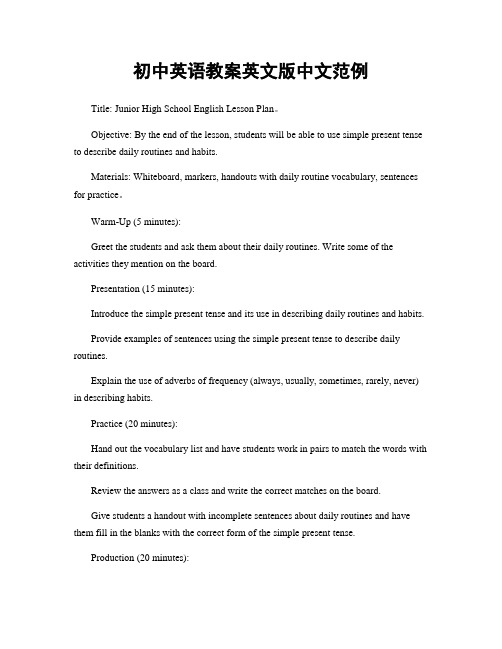
初中英语教案英文版中文范例Title: Junior High School English Lesson Plan。
Objective: By the end of the lesson, students will be able to use simple present tense to describe daily routines and habits.Materials: Whiteboard, markers, handouts with daily routine vocabulary, sentences for practice。
Warm-Up (5 minutes):Greet the students and ask them about their daily routines. Write some of the activities they mention on the board.Presentation (15 minutes):Introduce the simple present tense and its use in describing daily routines and habits.Provide examples of sentences using the simple present tense to describe daily routines.Explain the use of adverbs of frequency (always, usually, sometimes, rarely, never) in describing habits.Practice (20 minutes):Hand out the vocabulary list and have students work in pairs to match the words with their definitions.Review the answers as a class and write the correct matches on the board.Give students a handout with incomplete sentences about daily routines and have them fill in the blanks with the correct form of the simple present tense.Production (20 minutes):Divide the class into small groups and give each group a set of daily routine flashcards.Instruct the students to create a short skit using the flashcards to show different daily routines. Encourage them to use adverbs of frequency in their skits.Have each group perform their skit for the class.Review and Homework (5 minutes):Review the key points of the lesson and ask if there are any questions.Assign homework to students to write a paragraph about their own daily routines using the simple present tense and adverbs of frequency.Assessment:Observe students' participation in the activities and their ability to use the simple present tense and adverbs of frequency accurately in their skits and written homework.Closure:Summarize the key points of the lesson and remind students of the homework assignment.This lesson plan is designed to help students understand and use the simple present tense to describe daily routines and habits. The activities are interactive and engaging, allowing students to practice the language in pairs and groups. By the end of the lesson, students should feel confident in using the simple present tense and adverbs of frequency to talk about their daily lives.。
初中英语教案模板中英结合
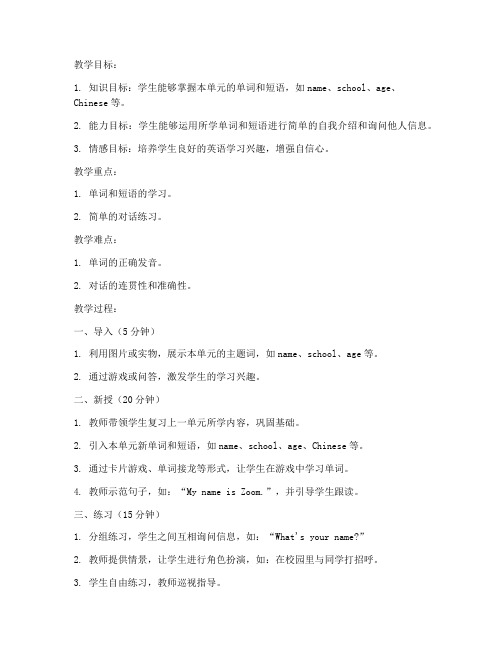
教学目标:1. 知识目标:学生能够掌握本单元的单词和短语,如name、school、age、Chinese等。
2. 能力目标:学生能够运用所学单词和短语进行简单的自我介绍和询问他人信息。
3. 情感目标:培养学生良好的英语学习兴趣,增强自信心。
教学重点:1. 单词和短语的学习。
2. 简单的对话练习。
教学难点:1. 单词的正确发音。
2. 对话的连贯性和准确性。
教学过程:一、导入(5分钟)1. 利用图片或实物,展示本单元的主题词,如name、school、age等。
2. 通过游戏或问答,激发学生的学习兴趣。
二、新授(20分钟)1. 教师带领学生复习上一单元所学内容,巩固基础。
2. 引入本单元新单词和短语,如name、school、age、Chinese等。
3. 通过卡片游戏、单词接龙等形式,让学生在游戏中学习单词。
4. 教师示范句子,如:“My name is Zoom.”,并引导学生跟读。
三、练习(15分钟)1. 分组练习,学生之间互相询问信息,如:“What's your name?”2. 教师提供情景,让学生进行角色扮演,如:在校园里与同学打招呼。
3. 学生自由练习,教师巡视指导。
四、巩固(10分钟)1. 完成课本上的练习题,如:单词拼写、句子改写等。
2. 教师挑选部分练习题进行讲解,帮助学生巩固所学知识。
五、小结(5分钟)1. 教师总结本节课所学内容,强调重点和难点。
2. 学生分享自己的学习心得,互相鼓励。
六、作业布置1. 复习本节课所学单词和短语。
2. 完成课本上的练习题。
3. 预习下一节课的内容。
教学反思:1. 本节课通过多种教学手段,激发学生的学习兴趣,提高学习效果。
2. 在教学过程中,关注学生的个体差异,因材施教。
3. 加强课堂互动,提高学生的口语表达能力。
教学资源:1. 课本2. 图片、卡片3. 多媒体课件教学评价:1. 课堂参与度2. 课堂练习正确率3. 学生对所学知识的掌握程度。
初中英文教案模板全英文
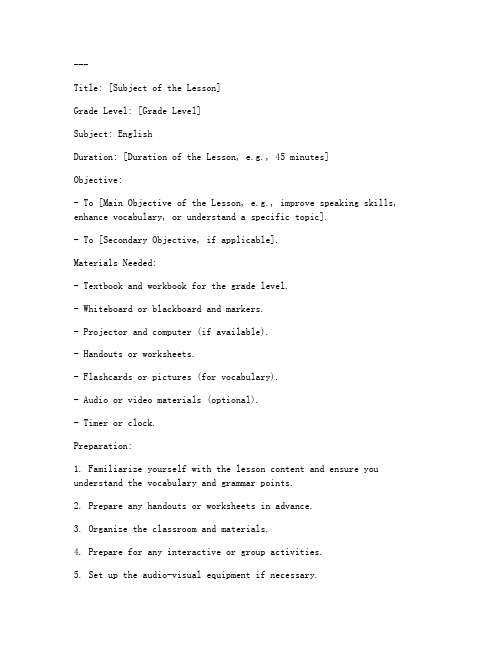
Title: [Subject of the Lesson]Grade Level: [Grade Level]Subject: EnglishDuration: [Duration of the Lesson, e.g., 45 minutes]Objective:- To [Main Objective of the Lesson, e.g., improve speaking skills, enhance vocabulary, or understand a specific topic].- To [Secondary Objective, if applicable].Materials Needed:- Textbook and workbook for the grade level.- Whiteboard or blackboard and markers.- Projector and computer (if available).- Handouts or worksheets.- Flashcards or pictures (for vocabulary).- Audio or video materials (optional).- Timer or clock.Preparation:1. Familiarize yourself with the lesson content and ensure you understand the vocabulary and grammar points.2. Prepare any handouts or worksheets in advance.3. Organize the classroom and materials.4. Prepare for any interactive or group activities.5. Set up the audio-visual equipment if necessary.Warm-up (5 minutes)1. Activity: Quickfire Questions- Ask students to answer a series of quick questions related to the theme of the lesson to stimulate their thinking and engage them in English.- Example questions: "What is your favorite animal?" "Where do you like to go on vacation?"2. Purpose: To review previous learning and get students thinking in English.---Introduction (5 minutes)1. Activity: Brainstorming- Write the main topic of the lesson on the board and ask students to brainstorm related ideas.- Example: For a lesson on "Hobbies," ask students to think of different hobbies they know.2. Purpose: To introduce the topic and get students thinking about the lesson content.---Main Content (20 minutes)1. Activity: Reading Comprehension- Read a passage from the textbook or hand out a worksheet with a reading passage.- Have students read silently and then discuss the main ideas with a partner.2. Purpose: To develop reading skills and understanding of the text.3. Activity: Vocabulary Building- Introduce new vocabulary related to the lesson theme.- Use flashcards or pictures to help students visualize and remember the words.- Practice using the new vocabulary in sentences.4. Purpose: To expand students' vocabulary and improve their ability to express themselves in English.5. Activity: Grammar Practice- Introduce and explain a new grammar point relevant to the lesson.- Provide examples and have students practice the grammar point in sentences or short texts.6. Purpose: To enhance students' grammatical knowledge and usage.---Practice (15 minutes)1. Activity: Pair Work- Assign a task that requires students to work in pairs, such as creating a dialogue based on the reading passage or discussing the vocabulary.2. Purpose: To encourage communication and reinforce learning through collaboration.3. Activity: Group Activity- Divide the class into small groups and give each group a different task related to the lesson, such as creating a poster or a presentation.4. Purpose: To promote teamwork and critical thinking.---Conclusion (5 minutes)1. Activity: Summarization- Ask students to summarize the main points of the lesson and what they have learned.- Example: "What are the main hobbies we discussed today?" "What new vocabulary did we learn?"2. Purpose: To reinforce learning and ensure students understand the key concepts.3. Activity: Homework Assignment- Assign homework that reinforces the lesson content, such as writing a short essay or completing a workbook exercise.4. Purpose: To extend learning beyond the classroom.---Assessment:- Evaluate students'。
初中英语语法教案模板全英
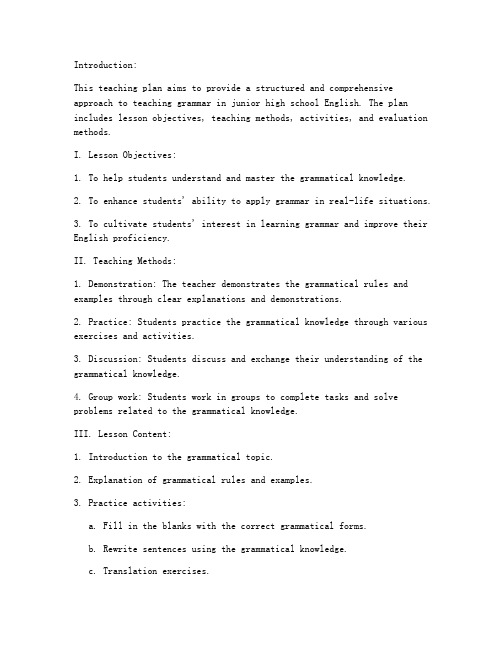
Introduction:This teaching plan aims to provide a structured and comprehensive approach to teaching grammar in junior high school English. The plan includes lesson objectives, teaching methods, activities, and evaluation methods.I. Lesson Objectives:1. To help students understand and master the grammatical knowledge.2. To enhance students' ability to apply grammar in real-life situations.3. To cultivate students' interest in learning grammar and improve their English proficiency.II. Teaching Methods:1. Demonstration: The teacher demonstrates the grammatical rules and examples through clear explanations and demonstrations.2. Practice: Students practice the grammatical knowledge through various exercises and activities.3. Discussion: Students discuss and exchange their understanding of the grammatical knowledge.4. Group work: Students work in groups to complete tasks and solve problems related to the grammatical knowledge.III. Lesson Content:1. Introduction to the grammatical topic.2. Explanation of grammatical rules and examples.3. Practice activities:a. Fill in the blanks with the correct grammatical forms.b. Rewrite sentences using the grammatical knowledge.c. Translation exercises.4. Group work activities:a. Role-playing scenarios to apply the grammatical knowledge.b. Discussion on the use of the grammatical knowledge in daily life.IV. Teaching Process:1. Introduction (5 minutes)a. The teacher introduces the grammatical topic and its importance.b. Students share their prior knowledge about the topic.2. Explanation (10 minutes)a. The teacher explains the grammatical rules and examples using visual aids and examples.b. Students take notes and ask questions.3. Practice (15 minutes)a. The teacher provides exercises for students to practice the grammatical knowledge.b. Students complete the exercises individually or in pairs.4. Discussion (10 minutes)a. The teacher poses questions to encourage students to discuss the grammatical knowledge.b. Students share their opinions and experiences.5. Group work (15 minutes)a. Students work in groups to complete tasks related to the grammatical knowledge.b. The teacher monitors and assists the groups as needed.6. Conclusion (5 minutes)a. The teacher summarizes the key points of the lesson.b. Students reflect on what they have learned.V. Evaluation Methods:1. Quizzes and tests to assess students' understanding of the grammatical knowledge.2. Observations of students' participation in class activities and group work.3. Students' self-assessment and peer assessment.VI. Follow-up Activities:1. Assign homework to reinforce the grammatical knowledge.2. Provide additional resources for students to further explore the grammatical topic.3. Organize grammar competitions or games to motivate students topractice grammar actively.Conclusion:This grammar teaching plan for junior high school English aims toprovide a structured and engaging approach to teaching grammar. By incorporating various teaching methods and activities, the plan aims to enhance students' understanding and application of grammatical knowledge, ultimately improving their English proficiency.。
英语教案全英文模板初中
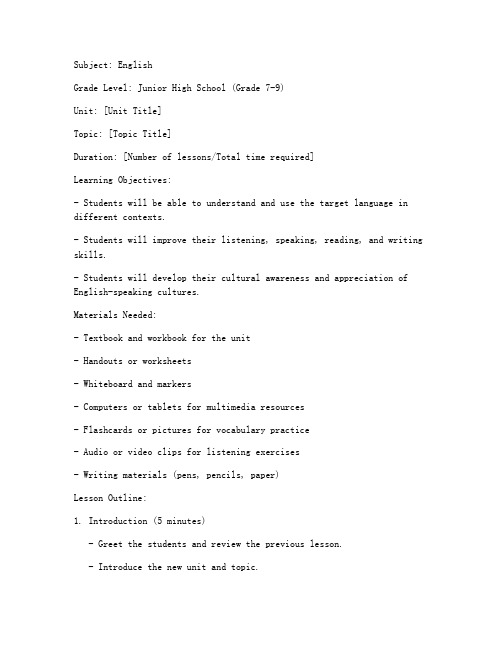
Subject: EnglishGrade Level: Junior High School (Grade 7-9)Unit: [Unit Title]Topic: [Topic Title]Duration: [Number of lessons/Total time required]Learning Objectives:- Students will be able to understand and use the target language in different contexts.- Students will improve their listening, speaking, reading, and writing skills.- Students will develop their cultural awareness and appreciation of English-speaking cultures.Materials Needed:- Textbook and workbook for the unit- Handouts or worksheets- Whiteboard and markers- Computers or tablets for multimedia resources- Flashcards or pictures for vocabulary practice- Audio or video clips for listening exercises- Writing materials (pens, pencils, paper)Lesson Outline:1. Introduction (5 minutes)- Greet the students and review the previous lesson.- Introduce the new unit and topic.- Explain the learning objectives for the lesson.2. Warm-Up (10 minutes)- Engage the students with a brief activity or game related to the topic.- Example: A quick quiz on previously learned vocabulary or a discussion about a related current event.3. Vocabulary (15 minutes)- Introduce new vocabulary through visual aids, such as flashcards or pictures.- Use a TPR (Total Physical Response) activity to reinforce vocabulary.- Have students practice forming sentences using the new vocabulary.4. Reading (15 minutes)- Present a short passage or article related to the topic.- Guide students through reading comprehension questions.- Discuss the content and main ideas of the passage.5. Listening (10 minutes)- Play an audio clip or watch a short video related to the topic.- Have students answer questions about the listening material.- Discuss the content and key points of the listening activity.6. Speaking (15 minutes)- Conduct a role-play or group discussion based on the topic.- Use prompts or scenarios to encourage students to use the target language.- Circulate and provide feedback and support to students.7. Writing (15 minutes)- Assign a writing task related to the topic.- Provide a sample or model to guide students.- Circulate and assist students with their writing.8. Review and Closure (10 minutes)- Summarize the key points of the lesson.- Review any homework assignments or upcoming tests.- Encourage students to ask questions or share their thoughts.Assessment:- Formative Assessment:- Participation in class activities and discussions.- Completion of in-class exercises and activities.- Peer and self-assessment.- Summative Assessment:- Quizzes and tests on the unit's vocabulary and grammar.- A written assignment or project related to the topic.- An oral presentation or performance task.Homework:- Assign a relevant reading or listening activity from the textbook or other resources.- Provide writing prompts or practice exercises to reinforce the lesson's content.- Encourage students to review the vocabulary and prepare for the next lesson.Notes:- Adjust the lesson plan as needed based on student responses and progress.- Incorporate technology and multimedia resources to enhance student engagement.- Differentiate instruction to meet the needs of all learners.- Maintain a positive and supportive learning environment.Teacher Reflection:- After the lesson, reflect on what worked well and what could be improved.- Consider how to adapt the lesson for future classes or different learning levels.- Document any observations or insights for professional development purposes.。
八年级下册英语教案全英文版

八年级下册英语教案全英文版Unit 1 What's the matter?一、Teaching aims。
1. Students will be able to master the key vocabulary related to health problems and advice, such as "have a cold", "have a stomachache", "lie down", "take one's temperature", etc.2. Students will be able to use the target language "What's the matter?I have a... You should/shouldn't..." to talk about health problems and give advice.3. Students will be able to improve their listening and speaking skills through various activities.4. Students will develop the awareness of taking care of themselves and others' health.二、Teaching key points。
1. Master the key vocabulary and target language.2. Be able to use the target language to have a conversation about health problems and advice.三、Teaching difficult points。
初中英语教案模板全英文

初中英语教案模板全英文Student: The students of GradeTeaching Content: Go for it, students’ book of grade. Unit 1, the title is How do you study for a test? Section B,a,b,c.Teaching hour: One class hourTeaching plan:I. Teaching Aims:1. Learn and master new words, phrases and sentence patterns.2. Enable the students to talk in English about how to study English very well.3. Develop the students speaking and writing ability.II. Teaching Main Points:1. Improve the students’ speaking and writing ability.2. Master some phrases and some sentence patterns. III. Teaching Difficult Points:1. Phrases:first of all, later on, laugh at, take notes2. Sentence Patterns:Sb. be afraid to do sth.Sb. realize that –clauseIV. Teaching Methods:1. Fast reading to find out the general information about the passage.2. Question-and-answer activities to help the students to go through the whole passage.3. Individual, pair and group work to make every student work in class. V. Teaching Aids:The blackboardVI. Teaching Procedures:The Blackboard Design:人人教育一对一个性化辅导教案初一上重要语法:一.Where’s my schoolbag?询问某人或某物的位置,意思是·······在哪里。
初中英语全英万能教案模板

Teaching Objectives:- Knowledge Objective: Students will be able to understand and use the target vocabulary and grammar structures correctly in different contexts.- Skill Objective: Students will enhance their listening, speaking, reading, and writing skills through various activities.- Emotional Objective: Students will develop an interest in English learning and improve their confidence in using the language.Teaching Materials:- Textbook- Workbook- Flashcards- Whiteboard and markers- Multimedia resources (e.g., videos, songs)Teaching Procedures:I. Warm-up (5 minutes)1. Greeting: Begin with a greeting and ask students to introduce themselves in English.2. Review: Quick review of previously learned vocabulary or grammar.3. Icebreaker: A short activity to engage students, such as a riddle ora quick quiz.II. Presentation (10 minutes)1. Vocabulary: Introduce new vocabulary through pictures, flashcards, or realia.2. Grammar: Explain the target grammar structure with simple examples and explanations.3. Demonstration: Model the correct usage of vocabulary and grammar through a short dialogue or story.III. Practice (15 minutes)1. Pair Work: Students work in pairs to practice using the new vocabulary and grammar.2. Group Activity: Small group activities that require students to apply the language in a real-life context.3. Role-Play: Students act out a scenario using the new vocabulary and grammar.IV. Production (10 minutes)1. Creative Writing: Students write a short paragraph or a dialogue using the new vocabulary and grammar.2. Oral Presentation: Students present their writing to the class, and peers can give feedback.3. Game: A language game that reinforces the target vocabulary and grammar.V. Consolidation (10 minutes)1. Summary: Review the main points of the lesson.2. Homework Assignment: Assign a homework task related to the lesson, such as writing a journal entry or preparing for a quiz.3. Closing Activity: A fun activity to review the lesson, such as a song or a game.VI. Assessment (Throughout the lesson)- Formative Assessment: Observe students' participation, engagement, and ability to use the language during activities.- Summative Assessment: Evaluate students' understanding of the new vocabulary and grammar through quizzes, tests, or presentations.Teaching Tips:- Use visuals and realia to make the lesson more engaging.- Encourage students to speak in complete sentences and provide positive feedback.- Be patient and supportive, especially with students who may be nervous or struggling.- Incorporate different learning styles into the lesson to cater to all students.Example of a Lesson Plan:Lesson Title: "My Hobbies"Teaching Objectives:- Students will be able to describe their hobbies using the present simple tense.- Students will practice listening and speaking skills by discussing their hobbies with classmates.Teaching Procedures:I. Warm-up:- Greeting and introduction.- Quick review of the present simple tense with a flashcard activity.II. Presentation:- Introduce new vocabulary related to hobbies (e.g., painting, reading, traveling).- Demonstrate the present simple tense with examples and a short dialogue.III. Practice:- Pair work activity: Students discuss their hobbies with a partner.- Group activity: Students create a poster showcasing their hobbies.IV. Production:- Creative writing: Students write a short paragraph about their favorite hobby.- Oral presentation: Students present their paragraph to the class.V. Consolidation:- Summary of the lesson.- Homework assignment: Write a journal entry about。
初中英语教案模板范文英文版
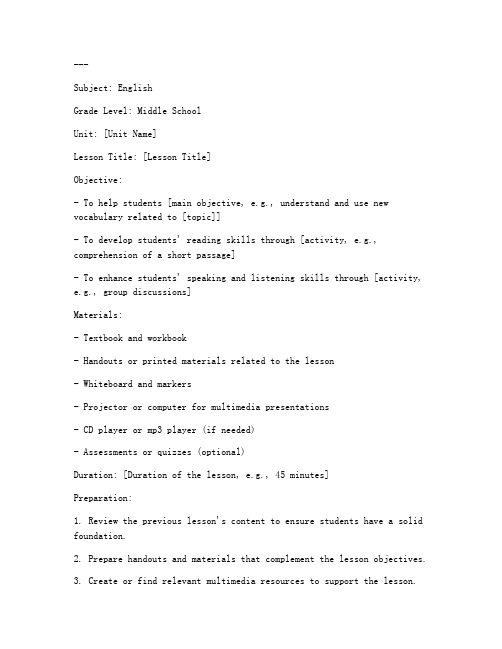
---Subject: EnglishGrade Level: Middle SchoolUnit: [Unit Name]Lesson Title: [Lesson Title]Objective:- To help students [main objective, e.g., understand and use new vocabulary related to [topic]]- To develop students' reading skills through [activity, e.g., comprehension of a short passage]- To enhance students' speaking and listening skills through [activity, e.g., group discussions]Materials:- Textbook and workbook- Handouts or printed materials related to the lesson- Whiteboard and markers- Projector or computer for multimedia presentations- CD player or mp3 player (if needed)- Assessments or quizzes (optional)Duration: [Duration of the lesson, e.g., 45 minutes]Preparation:1. Review the previous lesson's content to ensure students have a solid foundation.2. Prepare handouts and materials that complement the lesson objectives.3. Create or find relevant multimedia resources to support the lesson.4. Prepare questions and activities that align with the lesson goals.5. Arrange the classroom space to facilitate the planned activities.Procedure:1. Warm-Up (5 minutes)- Begin with a quick review activity from the previous lesson.- Use a game or a short quiz to engage students and activate prior knowledge.2. Introduction (5 minutes)- Introduce the topic of the lesson with a brief presentation or video clip.- Provide any necessary background information to set the context.3. Vocabulary Development (10 minutes)- Introduce new vocabulary related to the lesson topic.- Use flashcards, word games, or a matching activity to reinforce vocabulary.- Provide definitions and examples to help students understand the new words.4. Reading Activity (15 minutes)- Distribute a passage or text related to the lesson topic.- Guide students through a reading comprehension activity, such as:- Skimming to find the main idea- Scanning for specific information- Answering comprehension questions- Discussing the text in small groups5. Speaking and Listening Activity (10 minutes)- Organize a group discussion or role-play activity that allows students to practice speaking and listening skills.- Provide a scenario or prompt that encourages students to use the new vocabulary and concepts.6. Practice and Application (10 minutes)- Assign a writing task that requires students to use the new vocabulary and concepts learned in the lesson.- If time permits, allow students to work on this task during this part of the lesson.7. Wrap-Up (5 minutes)- Summarize the main points of the lesson.- Ask students to share their insights or experiences related to the topic.- Provide feedback on the lesson objectives and any homework or further reading assignments.Assessment:- Evaluate students' understanding of the lesson content through:- Participation in class activities- Completion of the reading and writing tasks- Group discussions and role-plays- Any quizzes or assessments administeredHomework:- Assign relevant homework tasks to reinforce the lesson, such as:- Reading an additional text or passage- Writing a short essay or summary- Reviewing and practicing the new vocabularyReflection:- After the lesson, reflect on the effectiveness of the activities and materials used.- Consider how the lesson objectives were met and identify areas for improvement.- Make notes for future lessons to ensure continuous progress and engagement.---This template can be adapted to fit various lesson topics and objectives within the middle school English curriculum.。
初中英语教案英文模板范文
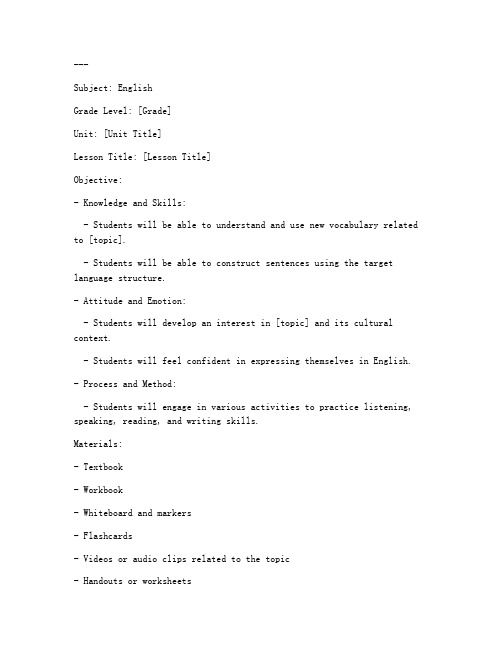
---Subject: EnglishGrade Level: [Grade]Unit: [Unit Title]Lesson Title: [Lesson Title]Objective:- Knowledge and Skills:- Students will be able to understand and use new vocabulary related to [topic].- Students will be able to construct sentences using the target language structure.- Attitude and Emotion:- Students will develop an interest in [topic] and its cultural context.- Students will feel confident in expressing themselves in English.- Process and Method:- Students will engage in various activities to practice listening, speaking, reading, and writing skills.Materials:- Textbook- Workbook- Whiteboard and markers- Flashcards- Videos or audio clips related to the topic- Handouts or worksheetsTeaching Aids:- Projector or computer for showing videos and slides- OHP or Smartboard- TimerPreparation:- Review the lesson content and ensure that all materials are ready.- Prepare vocabulary lists and example sentences.- Create activities and exercises that reinforce the learning objectives.- Familiarize yourself with the correct pronunciation and grammar.Procedure:1. Warm-up (5 minutes)- Greet students and ask them about their day.- Use a simple question-and-answer activity to engage students in English.- Introduce the topic of the lesson with a relevant question or statement.2. Introduction (10 minutes)- Present the new vocabulary and phrases related to the topic.- Use flashcards or the whiteboard to show the words and their meanings.- Provide example sentences to demonstrate how the words are used in context.3. Vocabulary Practice (15 minutes)- Engage students in vocabulary practice activities such as:- Matching activities: Students match words with their definitions or pictures.- Group activities: Students work in pairs or small groups to create sentences using the new vocabulary.- Role-plays: Students act out short scenarios using the new vocabulary.4. Grammar Focus (10 minutes)- Introduce the target language structure.- Explain the structure with examples and practice sentences.- Have students practice forming sentences with the new structure.5. Reading Comprehension (15 minutes)- Provide a text related to the topic.- Have students read the text silently or aloud.- Ask comprehension questions to check understanding.- Discuss the text as a class.6. Listening Activity (10 minutes)- Play a short video or audio clip related to the topic.- Have students listen and answer questions about the content.- Discuss the listening activity as a class.7. Writing Practice (15 minutes)- Provide a writing prompt related to the topic.- Have students write a short paragraph or essay using the new vocabulary and grammar structure.- Circulate around the classroom to provide feedback and assistance.8. Review and Conclusion (5 minutes)- Review the main points of the lesson.- Summarize the new vocabulary and grammar structure.- Ask students to share what they have learned.9. Homework Assignment (5 minutes)- Assign a homework task that reinforces the learning objectives.- Provide clear instructions and due dates.Assessment:- Observe student participation and engagement during activities.- Check homework assignments for understanding and application of the new material.- Administer quizzes or tests to assess knowledge and skills.---This template can be adapted to fit different teaching styles and learning objectives. It is important to tailor the lesson plan to the needs of the students and the specific curriculum being followed.。
初中英语课教案英文模板
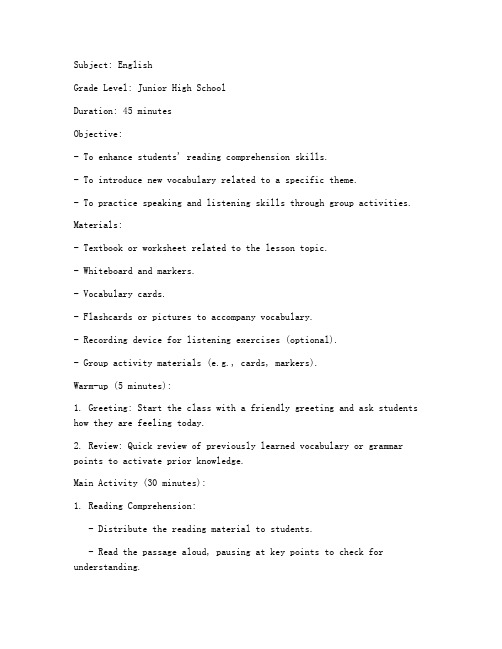
Subject: EnglishGrade Level: Junior High SchoolDuration: 45 minutesObjective:- To enhance students' reading comprehension skills.- To introduce new vocabulary related to a specific theme.- To practice speaking and listening skills through group activities.Materials:- Textbook or worksheet related to the lesson topic.- Whiteboard and markers.- Vocabulary cards.- Flashcards or pictures to accompany vocabulary.- Recording device for listening exercises (optional).- Group activity materials (e.g., cards, markers).Warm-up (5 minutes):1. Greeting: Start the class with a friendly greeting and ask students how they are feeling today.2. Review: Quick review of previously learned vocabulary or grammar points to activate prior knowledge.Main Activity (30 minutes):1. Reading Comprehension:- Distribute the reading material to students.- Read the passage aloud, pausing at key points to check for understanding.- Ask comprehension questions to ensure students have grasped the main ideas and details.- Discuss the passage as a class, encouraging students to share their thoughts and opinions.2. Vocabulary Introduction:- Introduce new vocabulary related to the lesson topic.- Use flashcards or pictures to illustrate the meanings of new words.- Have students practice using the new vocabulary in sentences.3. Group Activity:- Divide the class into small groups.- Assign a specific task or activity related to the lesson, such as:- Creating a poster using the new vocabulary.- Role-playing a dialogue based on the reading passage.- Discussing and comparing different perspectives on the topic.- Monitor groups to ensure they are working effectively and provide assistance as needed.4. Listening Exercise (optional):- Play a recorded audio related to the lesson topic.- Have students listen and answer comprehension questions.- Discuss the audio as a class, focusing on key points and language features.Conclusion (10 minutes):1. Summary: Summarize the main points of the lesson, emphasizing the new vocabulary and comprehension skills learned.2. Homework Assignment: Assign a homework task that reinforces the lesson's objectives, such as:- Writing a short paragraph using the new vocabulary.- Reading a related article or book.- Preparing a presentation for the next class.Assessment:- Observe students' participation and engagement during the lesson.- Assess students' understanding of the reading material through comprehension questions.- Evaluate the effectiveness of the group activity by observing the quality of the work produced.- Check homework submissions to gauge students' mastery of the new vocabulary and comprehension skills.Additional Notes:- Adapt the lesson plan to accommodate different learning styles and abilities.- Encourage students to ask questions and participate actively in class discussions.- Use varied teaching methods to maintain student interest and motivation.- Be mindful of cultural differences and ensure that the lesson content is inclusive and respectful.End of Lesson Plan。
中英对照初中英语教案模板(含全英内容)复习过程

Read the text and underline the words.
While-task activity 2: Group work
Work in groups to complete Part 2/3 on P5.
Emphasis on teaching
(教学重点)
Reading ability: read for details.
Vocabulary: thing,restaurant,wash,start,hot dog.
Key points: put on, at this moment, leave work,at home, get dressed, look at,see you soon
2.The others talk about what they are doing.
Some students would be asked to do some actions.
The others talk about what they are doing.
Presentation
(讲授新课)
Complementarywords: supper, who
Difficult sentence: Some are going to the opera orwatching a ballet.
(Some are going to see an operaor watch a ballet.)
Ideas of design
(设计思路)
Encourage the students
1. To predict what the text will be about by reading the title
- 1、下载文档前请自行甄别文档内容的完整性,平台不提供额外的编辑、内容补充、找答案等附加服务。
- 2、"仅部分预览"的文档,不可在线预览部分如存在完整性等问题,可反馈申请退款(可完整预览的文档不适用该条件!)。
- 3、如文档侵犯您的权益,请联系客服反馈,我们会尽快为您处理(人工客服工作时间:9:00-18:30)。
(教学重点)
Reading ability: read for details.
Vocabulary: thing,restaurant,wash,start,hot dog.
Key points: put on, at this moment, leave work,at home, get dressed, look at,see you soon
Board design
(板书设计)
Unit 2 They’re going to the opera.
Key points:watching a ballet.
put on, at this moment, leave work,Difficult sentence:
at home, get dressed, look at,Some are going to the opera orwatching a ballet.
2.The others talk about what they are doing.
Some students would be asked to do some actions.
The others talk about what they are doing.
Presentation
(讲授新课)
Basic Information
(基本信息)
Teacher(教师)
Stone
Type(课型)
New
Teaching material
(教材)
EEC Grade six(Book One)
Period(课时)
1 class
Teaching Model
(教学设计)
Contents of teaching
Practice
(情景操练/巩固练习)
1.Ask the students to read the title on Page 4&Part 2 on Page 5, then guess what will the text talk about.
2.After that, ask st8
udents to read and find out information.
Teaching Tool
(教具)
1.PPTplayer & mantle
2. Cards
中英对照初中英语教案模板
Teachingprocess
(教学流程)
Activities of teachers
(教师活动)
Activities of students
(学生活动)
Warming up
(情景导入/导入新课)
Review what they’velearntlast lesson.
1.Ask Ss to do some actions.
3.Then ask students to finish part3 on page5.
Pre-task activity: Pair work
Read the title on Page 4. Then discuss in pairs what the text will talk about. After discussion, some students should be asked to tell the whole class about their guessing.
Aims of teaching
(教学目标)
1.To get information from reading material about what people are doing in different places.
2.To get to know how to write a postcard.
Vocabulary and sentence structure
1.Words guessing
2.Say what the people in the photos are doing.
Students are supposed to match the new words with picture in Part 1 on Page 4, and to be able to read the new words, and then to know the meanings of the words.
(设计思路)
Encourage the students
1. To predict what the text will be about by reading the title
by askingthe students to read for details.
2. Tofind out how to write a postcard by reading the post card.
Complementarywords: supper, who
Difficult sentence: Some are going to the opera orwatching a ballet.
(Some are going to see an operaor watch a ballet.)
Ideas of design
Post-task activity: Group work
Present their answers.
Summary
(情景回归/归纳总结)
Text explanation
Discuss the sentences in the text, and try to get familiar with the words and phrases.
(教学内容)
Unit 2 They’re going to the opera.
Analysis of the teaching material
(教材分析)
The reading passage has so much information, and there are quite a few new words in it. This will help to improve students’ reading skill.
see you soon=Some are going to see an operaor watch a
Additional new words: supper, whoballet.
Homework
(作业布置)
1.Reading on Page 4and page90
2.Buying a new postcard FOR next lesson.
While-task activity 1: Individual work
Read the text and underline the words.
While-task activity 2: Group work
Work in groups to complete Part பைடு நூலகம்/3 on P5.
